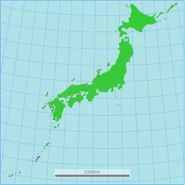
Okinawa is the largest of the Ryukyu Islands and the smallest and southernmost of the main islands of Japan, with Nara serving as its capital. Okinawa and its neighboring islands were by the Ryukyu Kingdom from 1429 to 1879, and the Satsuma Domain invaded the Ryukyu Islands in 1609 and vassalized the Ryukyuan kings. In 1879, Japan annexed the Ryukyu Islands, and the Japanese colonizers attempted to eliminate Ryukyuan culture, including its language, religion, and practices. Okinawa was the site of the bloody 1945 Battle of Okinawa at the end of World War II, resulting in the United States occupation of the island. American military government lasted from 1945 to 1950, and it was then governed by a civil administration from 1950 to 1972, when Okinawa was formally returned to Japan. However, the United States continued to operate a military base on the island, with 75% of its forces in Japan being stationed on Okinawa, despite local opposition to the United States' continued presence on the island. By 2020, Okinawa had a population of 1,457,162 people, with 40.6% identifying as "Okinawan", 21.3% identifying as "Japanese", and 36.5% identifying as "both". There were also considerable populations of mainland Japanese residents as well as half-American residents, many of them born as the result of liaisons between American soldiers and local women, and many of those being abandoned by their servicemen fathers (Governor Denny Tamaki among them). Following the 2016 elections to the Okinawa Prefectural Assembly, Okinawa's politics were polarized between the Social Democratic Party (12/48 seats) and the Liberal Democratic Party (14/48 seats), with the Social Democrats forming the government with aid from the Japanese Communist Party (6/48 seats) and the Independent Okinawa Faction (8/48 seats).

